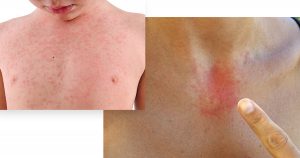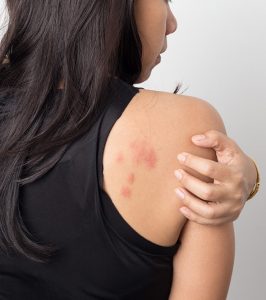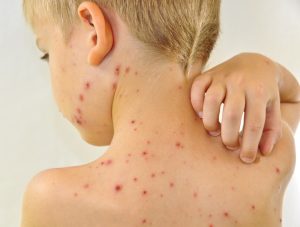
Contact Dermatitis Treatment in NY, NJ & CT
Do you experience contact dermatitis on your face or another part of your body? You’re not alone.
Contact dermatitis is a common skin condition triggered by an allergic reaction or irritation from touching a substance. Whether it’s a rash from a new necklace or redness from cleaning chemicals, it can be frustrating and uncomfortable.
There are two main types: irritant contact dermatitis (caused by direct irritation) and allergic contact dermatitis (caused by an allergic reaction). We can help diagnose the cause and find relief.
Are you ready to get back to comfortable skin? Contact Advanced Dermatology, P.C. today, or keep reading to learn more about contact dermatitis.
What is Contact Dermatitis?
Contact dermatitis is a dermatological skin condition that arises when your skin comes into contact with a substance that triggers an irritant or allergic reaction. This reaction is a common issue; the culprit could be anything from a new piece of jewelry to harsh chemicals.
Allergic Contact Dermatitis vs. Contact Dermatitis
While both fall under the umbrella of contact dermatitis, the underlying cause differs:
- Irritant Contact Dermatitis: This is a direct skin irritation caused by a harsh substance. It can happen to anyone, regardless of prior exposure. Think of it like rubbing your skin raw – the irritant disrupts the skin’s barrier, leading to inflammation. Common culprits include harsh soaps, detergents, solvents, or excessive friction.
- Allergic Contact Dermatitis: This involves an immune system response to an allergen that has touched the skin. It typically develops after repeated exposure, as your body becomes sensitized to the allergen. Examples include nickel in jewelry, fragrances in cosmetics, and poison ivy.
Here’s a table summarizing the key differences:

| Feature | Irritant Contact Dermatitis | Allergic Contact Dermatitis |
| Cause | Direct irritation from a substance | Allergic reaction to an allergen |
| Onset | Usually rapid (within hours or days) | Often takes days or even weeks after repeated exposure |
| Symptoms | Similar: redness, itching, dryness | May also include blistering, swelling |
| Who it Affects | Anyone | People who are sensitized to a specific allergen |
If you need help determining your type, consulting a dermatologist is crucial for proper diagnosis and treatment.

Contact Dermatitis Symptoms
A Contact dermatitis rash can manifest in various ways, but some common symptoms include:
- Redness: The affected area often appears red, inflamed, and irritated.
- Itching: Intense itching is a hallmark symptom, ranging from mild to severe.
- Dry, cracked skin: The irritated skin can become dry, cracked, and scaly.
- Blisters: In some cases, small, fluid-filled blisters may develop.
- Burning sensation: The affected area might feel burning or stinging.
- Swelling: Depending on the severity, the skin may become swollen and puffy.
The location and severity of symptoms can vary depending on the type of contact dermatitis and the specific irritant or allergen. For example, irritant contact dermatitis often affects the hands, while allergic contact dermatitis can appear anywhere on the body that has come into contact with the allergen.
If you’re experiencing any of these symptoms, it’s essential to consult a dermatologist for a proper diagnosis and to discuss treatment options.
Contact Dermatitis Causes
Everyday culprits can trigger contact dermatitis outbreaks, including:
- Metals: Nickel and others found in jewelry, belt buckles, or clothing snaps.
- Fragrances: In perfumes, colognes, lotions, and skincare products.
- Beauty Products: Makeup, skincare products, and nail polish.
- Latex: Found in rubber gloves, condoms, and some medical devices.
- Plants: Poison ivy, oak, and sumac can cause a reaction upon contact.
- Medications: Some topical medications, such as antibiotic ointments or corticosteroids.
- Chemicals: Found in cleaning products, solvents, and various other substances.
Diagnosis and Testing for Contact Dermatitis
Diagnosing contact dermatitis involves clinical assessment and testing to identify the specific allergen or irritant causing the skin reaction.
A dermatologist begins by taking a detailed medical history, including information about recent exposure to potential allergens or irritants. They may inquire about personal and family history of skin conditions or allergies.
A thorough physical examination is conducted to assess the affected skin. The dermatologist examines the rash, blisters, redness, and other symptoms to determine the type and severity of the dermatitis.
Patch testing is a common method to diagnose allergic contact dermatitis. During this test, small quantities of potential allergens are applied to adhesive patches, which are then placed on the patient’s skin, typically on the back. The patches remain in place for 48 hours, and then the patient returns for an evaluation. Any skin reactions observed can help identify the specific allergens responsible.
Skin prick tests are another way to diagnose allergic contact dermatitis. In this test, a diluted allergen solution is applied to the skin, and the dermatologist uses a small lancet to create a tiny prick or scratch on the skin’s surface. Any immediate skin reactions are monitored to identify allergens.
Sometimes, blood tests may be conducted to identify allergic reactions by measuring specific antibodies or immune responses to potential allergens. However, patch testing is often the preferred method for contact dermatitis diagnosis.
An elimination diet may be recommended for dermatitis related to food allergies to identify specific food triggers.
In rare cases, a skin biopsy may rule out other skin conditions or examine the extent of skin damage.
Contact Dermatitis Treatment
Both allergic contact dermatitis treatment and contact dermatitis treatments focus on managing and alleviating symptoms caused by skin reactions. The approach to treatment can vary depending on the type and severity of the dermatitis.
Some common treatment options include:
- Topical or oral corticosteroids
- Immuno-modulators like tacrolimus (Protopic) and pimecrolimus (Elidel)
- Oral antihistamines like cetirizine (Zyrtec) and loratadine (Claritin)
- Moisturizers and emollients
- Trigger avoidance
- Cool compresses
- Antibiotics
Consult a dermatologist to determine the most appropriate treatment plan for the type and severity of contact dermatitis.
Contact Dermatitis Healing: A Stage-by-Stage Breakdown
Contact dermatitis heals in stages, with the duration and intensity depending on severity and treatment. Here’s a breakdown of what you can expect:
- Inflammation: Redness, itching, and swelling occur as the body fights the irritant. (Hours to days)
- Blisters: Small, fluid-filled blisters may form (allergic dermatitis only). (Days)
- Oozing & Crusting: Blisters may burst, releasing fluid that dries and forms crusts. (Overlaps with stage 2)
- Healing: Itching and redness subside, and skin returns to normal. (Days to weeks)
- Hyperpigmentation (optional): Skin may darken in the affected area, usually fading over time. (Weeks to months)
- Complete Recovery: Skin returns to its pre-dermatitis state. (Variable)
Early treatment and avoiding triggers are key for faster healing.
FAQ About Contact Dermatitis
How do you cure contact dermatitis?
Contact dermatitis is caused by a foreign substance or object that comes in contact with your skin. The exact remedy will vary depending on the substance or object, the area that was affected, and the patient’s skin type, among other factors.
What does contact dermatitis look like?
This skin condition looks like a red rash that may, in some instances, have a rough texture. It can appear in most parts of the body.
What is the first sign of contact dermatitis?
The first sign of contact dermatitis is an itchy, numb, or uncomfortable sensation in the area exposed to the irritant.
Can contact dermatitis be caused by stress?
Unlike eczema and other dermatitis symptoms, contact dermatitis cannot be caused by stress. This condition is only caused by external elements that encounter your skin and produce an unwanted reaction.
Is contact dermatitis contagious?
No, Contact dermatitis is not contagious. It is not caused by an infectious agent like bacteria or viruses. Instead, it occurs when the skin reacts to an irritant or allergen, and it is not transmitted from person to person through direct contact.
Can contact dermatitis spread?
Not usually. Contact dermatitis typically doesn’t spread from one area of the body to another through contact with the affected skin. However, if exposure to the irritant or allergen continues, the condition may worsen or persist throughout the body.
When should I see a doctor for contact dermatitis?
If the rash appears suddenly, is extremely uncomfortable, or affects your daily life, you should see a skincare expert who can identify the potential source and offer a solution to soothe the discomfort.
